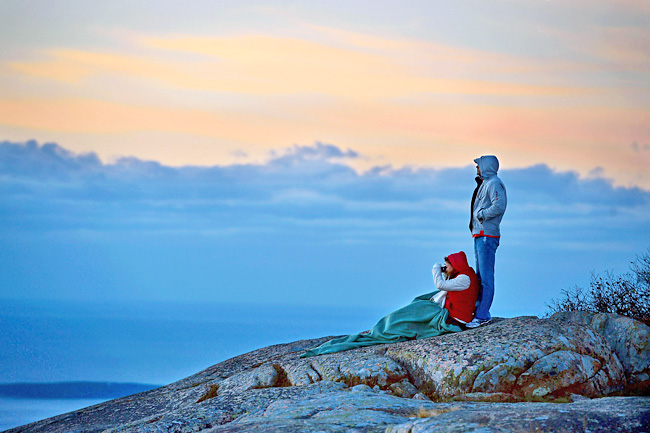Kasha Patel
THE WASHINGTON POST – There’s nothing like a sunset to stop you in your tracks. Whether you’re commuting, relaxing on vacation or quickly glancing out the window, the vibrant reds, oranges and yellows streaming from the sun grab your attention. So many of us think, “Wow.” We become momentarily speechless.
Now research tells us: Sunsets are among the most beautiful fleeting weather phenomenon in a day.
People find sunrises and sunsets to be the most beautiful and awe-inspiring weather, according to a study published this year from a pair of British researchers. People liked them more than storms, rainbows, clear blue skies or nightscapes – and some would even be willing to pay up to GBP100 to see landscapes at dawn or dusk.
Research has shown that spending time in nature under clear blue skies can boost your mental health, but the new research suggests perhaps looking at a sunset or sunrise can be an extra boost for your emotional state. That even includes sunsets on paintings or screen savers, too.
Awe has typically been a difficult emotion to evoke, said lead author Alex Smalley, but feelings of awe can improve mood, increase positive emotions and decrease stress.

Smalley’s research has shown that people can “experience these bumps in awe and aesthetic appraisal and beauty” when looking at a sunset or sunrise.
“We have, as Western populations, become very disconnected from the natural world,” said Smalley, a doctoral candidate at the University of Exeter in England. “When you see something vast and overwhelming or something that produces this feeling of awe, your own problems can feel diminished and so you don’t worry so much about them.”
But when is the best time of the year to see a sunset? What makes a sunrise and sunset so vivid? And can we predict them?
WHAT’S GOING ON IN THE ATMOSPHERE WHEN THE SUN RISES OR SETS?
Like an Instagram creator posing for a camera, sunsets and sunrises are all about angles. During the daytime, the sun stays more or less over our heads. Thus, sunlight takes a fairly direct, short path through the atmosphere to the ground. When the sun rises or sets, its position moves tangential to the ground, and the pathway from the sun to the ground is lengthened. That’s where the various color palettes come in.
As that pathway is lengthened, sunlight has the ability to hit more molecules in the air. The sun emits electromagnetic energy, but we can only see the energy from 400 nanometres (bluer part of the spectrum) to 700 nanometres (redder hues) as visible light. These molecules – like oxygen and nitrogen – are thousands of times smaller than the incoming visible wavelengths from the sun. (We’ll get to why size is important soon.)
Each one of those particles scatters, or changes the direction of, the sun’s visible energy. The air molecules scatter shorter wavelengths, such as blue and purples, removing them from our line of vision. Longer wavelengths, such as orange and red, can pass more freely to the ground, giving us the iconic sunset and sunrise colours.
Think of the atmosphere like a filter, one that you may put on your camera to change what colors you see. As the sun’s path to the ground is lengthened, the atmosphere will filter more light. Blues and purples are filtered out, but oranges and reds are allowed to pass through with less hindrance.
“Everything that you see, it’s a function of many, many scattering events,” said a meteorologist at the University of Oklahoma Steve Corfidi. “The sunlight hits the first particle it encounters in the atmosphere, then that particle shines or reflects that incoming light onto the particle next to it. This is just going on a multitude number of times before that light ultimately reaches your eyes.”
WHAT’S THE BEST SEASON FOR SUNSETS?
Summer is a tricky time to view sunsets. That’s because there is increased air pollution higher in the atmosphere, such as from wildfires. Those particles basically act as many mini mirrors, reflecting the light back to the sun or blocking it.
Such pollution droplets are much larger in size than the air molecules floating in our atmosphere, often comparable to the size of a visible wavelength of light. Often times, polluted sunsets look hazier and softer. Sometimes, polluted sunsets can look redder due to the high number of particles in the sky filtering out the blue wavelength of light.
The best time to view a sunrise or sunset is during the late fall and winter, Corfidi said, when the air is cleaner. Drier or less humid environments, such as the desert, also produce brilliant sunrises and sunsets due to the lower amount of air molecules (in this case, water vapour).
Clouds can also help enhance sunrises and sunsets by further reflecting sunlight to the ground. This can often be seen with more high-altitude clouds, which capture light from the sun before it can hit the atmosphere and undergo major filtering. Brilliant red, orange and scarlet sunsets often take place in the presence of higher cirrus or altocumulus clouds instead of low-level clouds such as stratus or stratocumulus.
BUT WHAT IF YOU KEEP MISSING THE SUNSET OR SUNRISE?
You woke up late. Storm clouds are in the way. A new high-rise building is blocking your sky view. A brilliant sunset doesn’t always come to light.
Predicting a vivid red and orange sunset isn’t a well-honed skill, said Corfidi, and it may never be. The main issue is that there is not enough data collection to pinpoint the timing or predict the phenomenon on the scale of cities. Theoretically, one could invest an enormous amount of resources to predict the atmospheric conditions of a sunset, but even then you might still be wrong.
“They are very ephemeral. If you watch them, they change over the order of minutes,” said Corfidi.
But Smalley said his new study indicates that you might not need to see the sunset in real-time or even in person. Much of his current research uses digital stimuli of nature, such as a screen saver, to test a person’s emotions.
He also works with an app called Portal, which uses immersive technology to transport people’s imaginations to beautiful places around the world.






